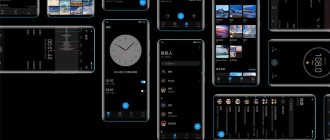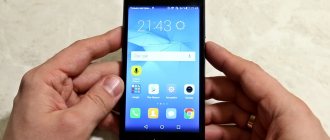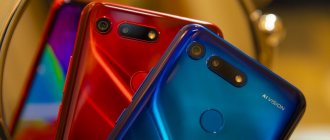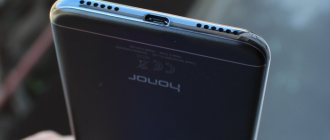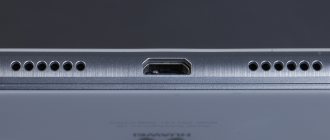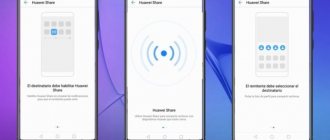Main characteristics of Huawei Honor 6 Plus
| Screen | S-IPS, 5.5″, 1080×1920, 16M colors, touch, capacitive, multi-touch 10 touches, work with gloves |
| Iron | 1.8 GHz, HiSilicon Kirin 925, 4 Cortex-A15 cores + 4 Cortex-A7 cores, Mali-T628 MP4 |
| Memory | RAM 3 GB, ROM 32 GB, Micro-SD up to 128 GB, memory card inserted into the slot for the second SIM card |
| Mobile Internet | LTE cat.6 300/50 Mbit/s HSDPA 46.7 Mbit/s, HSUPA 5.76 Mbit/s EDGE |
| Mobile networks | LTE Bands 1,3,7,38,39,40,41 (2100, 1800, 2600, 2600TDD, 1900TDD, 2300TDD, 2500TDD) UMTS 900, 2100 GSM 850, 900, 1800, 1900 |
| Battery | Li-Pol, 3600 mAh |
| Dimensions | 150.5 x 75.7 x 7.5 mm |
| Weight | 165 g |
| Camera | 8 MP, flash, autofocus, two 8 MP modules front: 8 MP |
| OS | Android 4.4 KitKat (4.4.2), EMUI 3.0 |
A shovel called Honor 6 Plus costs 26 thousand rubles. Nice shovel, I liked it. But here's the problem. A shovel from the same manufacturer with exactly the same dimensions, named Honor 4X, costs only 12 thousand rubles.
I recently tested Honor 4X. Moreover, in a rare case, I gave the device the maximum rating. In my opinion, XXXX simply has no competitors for comparable money.
And now he comes to me. Oh yeah. A smartphone of a “different class”, cool, stuffed with tasty goodies like a dual camera. And, naturally, a question arises for yourself. Are you ready, dear comrade, to pay twice as much money for such an upgrade? I put my combat SIM card in the Honor 6 Plus, walked around with it for a couple of weeks, and thought about it. And now I’m reporting. No, I'm not ready. I would buy an Honor 4X and put the excess money into a savings account.
The obvious advantages are a stronger camera and two radio modules. You can't argue, argument.
Is the screen cooler? Yes, definitely. More resolution - God bless him. But a good oleophobic coating is a solid plus.
Performance? I beg you. It's redundant. I don’t convert videos on smartphones and don’t mine bitcoins.
The batteries are comparable. Good in both devices.
Well, the disadvantages are the slipperiness of the case and the lack of support for LTE Band 20. The disadvantages are not fatal, although they are unpleasant.
And, one wonders, why pay twice as much?
Competitors
Phablets with a diagonal of 5.5 inches, decent hardware, LTE support, and not limited by memory.
As you can easily see from the table, if you don’t really chase top-of-the-line characteristics, you can save a fair amount.
Meizu m2 note and OnePlus One, like Honor 6+, do not support LTE Band 20 800 MHz.
| Chipset | Memory | Screen | Battery | Cameras | Price | |
| Honor 4X | Kirin 620 | 2+8+SD | S-IPS 720×1280 | 3000 | 13+5 | 12 thousand |
| Meizu m2 note | MTK6753 | 2+32+SD | S-IPS 1080×1920 | 3100 | 13+5 | 13-14 thousand |
| ZenFone 2 ZE550ML | Intel Z3560 | 2+16+SD | S-IPS 720×1280 | 3000 | 13+5 | 13-15 thousand |
| ZenFone 2 ZE551ML | Intel Z3580 | 4+64+SD | S-IPS 1080×1920 | 3000 | 13+5 | 14-18 thousand |
| OnePlus One | Snapdragon 801 | 3+64 | LTPS 1080×1920 | 3100 | 13+5 | 18-21 thousand |
| Lenovo P90 | Intel Z3560 | 2+32 | S-IPS 1080×1920 | 4000 | 13+5 | 20 thousand |
| LG G3 | Snapdragon 801 | 3+32+SD | S-IPS 1440×2560 | 3300 | 13+2 | 18-27 thousand |
| Honor 6 Plus | Kirin 925 | 3+32+SD | S-IPS 1080×1920 | 3600 | 8+8 | 26 thousand |
| LG G4 | Snapdragon 808 | 3+32+SD | S-IPS 1440×2560 | 3000 | 16+8 | 30-40 thousand |
Honor 6 plus - screen
5.5-inch; 1080 by 1920 pixels (Full HD); 401ppi; IPS matrix; Gorilla Glass 3
The large 5.5-inch display on the Honor 6 Plus takes up most of the smartphone's width, leaving just 2.8mm for the side bezels. This is done for good viewing of images and gives the smartphone respectability.
We liked the screen on the Huawei P8, so we wouldn't be surprised if the Honor 6 Plus has the same panel inside. The image quality is fantastic, especially considering the price. We can say that it is comparable to the Quad HD Super AMOLED display in the Galaxy S6.
In this case, the user is given the opportunity to adjust the image, its brightness and contrast in the settings, but this was not useful to us, since the preset settings suited us quite well. The screen is large and bright enough to see the image in any lighting conditions.
Appearance
| Weight | 165 g |
| Size | 150.5 x 75.7 x 7.5 mm |
| Protection | No |
It’s clear - it’s quite big. Clearly, it’s not fluff.
Theoretically, it comes in three color options. White, black, golden. In fact, in the company store there are now only black and white models for sale. A golden device arrived for testing.
It’s beautiful, even if it’s overtly glossy.
Front and back are glass. What’s nice is that the prints are almost invisible on either side.
The frame on top and sides is metal.
The frame on the bottom and thin strips between the metal and glass are, apparently, plastic.
The smartphone is not separable. To install SIM cards and memory cards, a traditional staple-tray system is used (see the video with the first introduction at the end of the review).
The cards were dealt with in an original way. There are two trays. In the first one you can install either a Nano-SIM or a Micro-SD memory card. In the second - only Micro-SIM. Those. Either you use two SIM cards without a memory card, or one SIM card and a memory card. What prevented us from making three trays is a great mystery. Clearly not a lack of space. With this size of the case, you can place at least five trays on each side.
Boring details about appearance with photographs
Before. Above the screen, as usual, are sensors, a front camera, and a speaker. There is also an LED to notify you about anything different.
There is nothing under the screen, the android buttons are on the screen.
Rear The dual camera and dual flash are placed in the upper left corner. In the lower left corner there is a small slot for the main speaker. By the way, despite its modest size, the speaker is quite loud.
Top. 3.5mm audio output, IR emitter, noise canceling microphone.
Bottom. Main microphone, Micro-USB connector.
On the right are buttons. Volume rocker and power-lock button. The location is good, but the buttons are quite close to each other and are difficult to distinguish by touch. In this regard, of course, Sony is acting wiser by making the power button round. There's definitely no confusion there.
There is nothing on the left.
Honor 6 plus – design
Fiberglass; 150.5 x 75.7 x 7.5 mm; 165g.
The body of the smartphone is made of fiberglass, which makes it incredibly durable and at the same time beautiful. The same material is used to make military helmets, so there is no doubt about its strength.
The smartphone is offered in traditional black and white versions. The Honor 6 Plus is also available in a gold variant, and to be honest, its looks are eye-catching. While Huawei may take inspiration from the iPhone 5S, it still has its own unique touches like shiny metal side panels, textured volume keys, and more.
Of course, the Honor 6 Plus is no iPhone 6 or Samsung S6, but it does have a microSD card slot to expand its 16 or 32 GB of storage up to 128 GB, so it's safe to say that this is one of the best smartphones that came out recently. If you are looking for something attractive and inexpensive, then take a closer look at the Honor 6 Plus.
Internals (iron)
| AnTuTu | 44886 (v5.7.1) |
| Chipset | 1.8 GHz, HiSilicon Kirin 925 |
| Cores | 4 Cortex-A15 1.8 GHz 4 Cortex-A7 1.3 GHz |
| GPU | Mali-T628 MP4 |
| RAM (free) | 3 GB (2 GB) |
| ROM (free) | 32 GB (25 GB) |
| Micro-SD | Up to 128 GB |
Everything is fast, beautiful and smooth. And there’s also a lot of memory. The smartphone has no problems with the hardware.
In parrot tests, of course, Honor 6+ beats Honor 4X... Let's say, by tens of percent. But not at times, of course.
Look at the results of my trivial tests. They are quite curious.
| Chipset | Pi | Nerdy Birds | Big Page2 | Heavy Book2 | |
| Huawei Honor 6 Plus | Kirin 925 | 3.37 | 6.96 | 4.49 | 3.38 |
| Huawei Honor 4X | Kirin 620 | 4.25 | 7.87 | 6.42 | 5.32 |
| Samsung Galaxy S6 edge | Exynos 7420 | 2.79 | 6.85 | 4.38 | 3.17 |
| Sony Xperia Z3 | Snapdragon 801 | 6.39 | 6.52 | 5.75 | 3.70 |
| MegaFon Login+ | MTK6582M | 17.62 | 8.57 | 7.77 | 5.64 |
Synthetic parrot tests (2 photos)
The set of sensors is normal. Accelerometer, gyroscope, compass, proximity sensor, light sensor.
Huawei Honor 6 Plus smartphone review: with a camera duo
The ratings for the Huawei Honor 6 Plus smartphone turned out to be at least half a step higher than its predecessor. At the same time, the most unusual “highlight” of the new device was its dual main camera. Vesti.Hi-tech looked not only for the pros, but also for the cons of the new product being tested
The announcement of the Huawei Honor 6 Plus smartphone coincided with the first anniversary of the Honor brand itself, which was created in December 2013 and over the past twelve months had reached a sales level of 20 million units. Without much doubt, the company's employees compared their new device with the 5.5-inch iPhone 6 Plus. Even the slogan for the promotion of Honor 6 Plus was chosen so that it would echo with some challenge the advertising slogan of the iPhone 6 Plus (Bigger than bigger). Of course, we cannot avoid parallels with the i-device, but we will focus on the original features of the Honor 6 Plus as an Android device. Let's see what advantages it has compared to, say, its predecessor - the usual “six” Honor 6. After all, it’s been known since school that the “plus” sign raises the mark by half a step.
Specifications
- Model: PE-TL10
- OS: Android 4.4.2 with EMUI 3.0 shell
- Processor: 8-core HiSilicon Kirin 925, ARM big.LITTLE GTS architecture (4 Cortex-A15 1.8 GHz cores + 4 Cortex-A7 1.3 GHz cores), Smart i3 coprocessor for working with sensors (230 MHz)
- Graphics coprocessor: ARM Mali-T628 MP4 (600 MHz)
- RAM: 3 GB
- Storage memory: 32 GB, microSD/HC/XC card support (up to 128 GB)
- Screen: JDI, in-cell, capacitive, IPS matrix, 5.5-inch diagonal, resolution 1920x1080 pixels, pixel density per inch 401 ppi, contrast ratio 1500:1, glove control, Corning Gorilla Glass 3
- Interfaces: Wi-Fi 802.11 b/g/n (2.4 GHz + 5 GHz), Wi-Fi Direct, Bluetooth 4.0 + EDR, microUSB (USB 2.0) for charging/synchronization, USB-OTG, NFC, IR port , 3.5mm headphone
- Cameras: main – dual (8 MP + 8 MP), Sony Exmor RS (BSI sensor), f/2.0 aperture (software f/0.95-f/16), 5-element optics, EGF 28 mm (software from 70 mm ), autofocus, dual flash, [email protected] fps video recording, front 8 MP, f/2.4 aperture, [email protected] fps
- Network: 2G, 3G (HSPA+, up to 42 Mbit/s), 4G (LTE Cat 6, up to 300 Mbit/s)
- SIM card: two, microSIM (3FF) and nanoSIM (4FF) formats
- Navigation: GPS/GLONASS/Beidou, A-GPS
- Radio: FM tuner
- Sensors: accelerometer, compass, gyroscope, light and proximity sensors
- Battery: non-removable, lithium polymer, 3,500 mAh
- Colors: white, black, gold
- Dimensions: 150.46x75.68x7.5 mm
- Weight: 165 grams
Design, ergonomics
The creators of the new Huawei smartphone did not use the combination “6 Plus” by accident. Firstly, compared to the previous model – Honor 6, its sequel, while maintaining the main details of the exterior, turned out to be, if only a little, cooler in almost all key parameters (from processor power to battery capacity).
After all, although both devices are quite similar in appearance, even the plastic bezel around the perimeter of the Honor 6 Plus was replaced with a metal one.
And, secondly, the iPhone 6 Plus served for developers from Huawei, apparently, as the standard they looked up to and wanted to surpass. This can also explain that the screen diagonal (5.5 inches), some design elements, as well as the body colors (black, white, gold) of the Honor 6 Plus amazingly coincide with this “style icon”.
However, the new gadget from Huawei fits more comfortably in the hand, since it is shorter and narrower: (150.46 x 75.68 mm) versus (158.1 x 77.8 mm). But the thickness and weight of both “sixes plus” are, respectively, (7.5 mm and 165 g) versus (7.1 mm and 172 g). That is, Honor 6 Plus turns out to be thicker but lighter than the iPhone 6 Plus, which, however, is easily explained. The fact is that the design of the new smartphone, like its predecessor Honor 6, uses composite technologies.
So, the back panel was made from fiberglass, under one of the transparent layers of which (especially in the gold case) a nice “waffle” texture is clearly visible. Fingerprints on such a panel are less noticeable than, say, on glossy plastic. By the way, the thickness of the 5-inch Honor 6 is the same (7.5 mm), but the weight, of course, is less (135 g). Impact-resistant zinc was used for the frame of the new smartphone. But to remove heat from microcircuits, special graphite heat exchangers are used.
It is worth noting that Honor 6 Plus received rather thin frames (2.8 mm) on the sides of the display, thanks to which the latter occupied 78.2% of the entire front panel. Let us remind you that for the iPhone 6 Plus this value is only 71.1%. Of course, the entire front surface of the new smartphone, including the screen, is fully protected by Corning Gorilla Glass 3 with oleophobic coating.
Above the display are an LED charging/event indicator, a front camera lens, a speaker grille, and above it are proximity and light sensors.
The touch control keys “Back”, “Home” and “Recent applications” are on-screen here, and their icons are made in the Lollipop style - “triangle”, “circle”, “square”, respectively. Your smartphone's settings provide options for controlling this navigation bar, including the location and number of buttons displayed.
The left edge of the body is empty,
and on the right side there is a power/lock button and a volume rocker, below which two slots are hidden under plugs. In this case, you can use a thin paper clip as a master key for locks. The bottom slot is for a SIM card (microSIM format), and the second (closer to the power/lock button) is universal, for another subscriber identification module (nanoSIM format - clearly a tribute to the iPhone 6 Plus), or for a microSD memory card.
At the bottom end there is a microUSB connector and a hole for a “conversational” microphone,
and on the top there is a 3.5 mm jack for an audio headset and a hole for a second microphone (noise reduction), as well as an IR port window.
At the top of the non-removable rear panel, decorated with the “honor” logo, there is a place for windows for the lenses of the dual main camera, as well as a dual LED flash (it also serves as a flashlight),
The lower part of the panel was occupied by a literally inconspicuous grille of a “multimedia” speaker, and, in addition, inscriptions indicating, in particular, the model number, company and country of manufacture.
There are no complaints about the assembly of the device.
But its size may seem a little big to some. In this case, it is recommended to use the functionality of the settings designed to control the smartphone with one hand. The tactile sensations from the back panel material are quite pleasant; it is less slippery than regular glass, but in some cases it is safer to operate the Honor 6 Plus with two hands. By the way, Huawei even filmed a video about the strength of the 6-layer composite where it can withstand a shot from an air rifle. If this were in the dashing 90s, the “right guys” would have lined up in a long line for such devices.
Screen, camera, sound
On the generally small size, Honor 6 Plus was able to fit a 5.5-inch screen with an IPS matrix, which was prepared by JDI using In-Cell technology (One Glass Solution option). In this case, one conductive touch layer is integrated with a thin film transistor (TFT) layer that drives the LCD screen, so there is no additional air gap. Full HD resolution (1920x1080 pixels) provides a pixel density per inch of 401 ppi. The viewing angles of the matrix are very large. The screen contrast is 1500:1, while the smartphone developers did not fail to note that the advantage in this parameter compared to the iPhone 6 Plus in favor of the Honor 6 Plus is 15%. At the same time, color saturation is 20% greater than that of smartphones of the same class.
It is proposed to adjust the backlight brightness level manually or use automatic adjustment based on data from the built-in light sensor. You can easily change the color temperature of the screen at your discretion - make the colors warmer or, conversely, cooler.
The touch capacitive screen clearly responds to pressure and recognizes up to ten simultaneous touches. This multi-touch is confirmed by the results of the AnTuTu Tester and MultiTouch Tester programs. In the “Manage/More...” settings you can find an option to activate operation of the smartphone with gloves. Protective glass Corning Gorilla Glass 3 with oleophobic coating not only protects the display from scratches, but also allows you to quickly clean it from small dirt. In general, the screen definitely deserves a bold “plus”. Plus, compared to the Honor 6's 5-inch display, it's at least 0.5 inches larger.
The photo capabilities of the Honor 6 Plus claim two or even three “pluses” at once. The fact is that the main camera here is dual, or rather, consists of two identical 8-megapixel BSI Sony Exmor RS sensors with two 5-element lenses, the effective focal length (EF) of which is 28 mm, and the aperture is f/2.0 . Of course, autofocus and dual LED flash are also present. By the way, the thickness of this assembly is less than 7.5 mm, so the photo module does not protrude above the smartphone body. Focusing speed is declared at 0.1 seconds. It is especially worth paying attention to the large pixel size – 1.98 microns, which indicates good photosensitivity. The manufacturer notes that thanks to this, the quality of photos taken at night is 60% higher than that of conventional cameras. The images obtained from both cameras are combined into one, equivalent, to a maximum, of a 13-megapixel matrix with a classic aspect ratio of 4160x3120 pixels (4:3). Software processing (3IE algorithm) allows you to emulate the aperture of a virtual lens in the range f/2.0-f/0.95. Due to this, it is easy to obtain versions of the same image with different depths of field, for example, as shown below
Something similar is implemented, for example, in Duo Camera from HTC One (M8). By the way, in the Honor 6 Plus menu, in addition to the obligatory “Photo” and “Video”, there is even a separate “Aperture” mode, which, for obvious reasons, is absent in the regular “six”.
The front camera, to the delight of selfie lovers, is also equipped with an 8-megapixel sensor (versus 5 MP in Honor 6) and a lens with an f/2.4 aperture. But the maximum size of her image is 3264x2448 pixels (4:3). Both cameras can record Full HD video (1080p) with a frame rate of 30 fps, while the videos are saved in MP4 container files (video - MPEG4, audio - AAC). Examples of photos with the camera base can be seen here (Dropbox).
The interface of the Camera application is quite simple and concise. The main photo module provides several special shooting modes, including HDR, Panorama, Night Shot, Good Photos, etc. In addition to selecting image resolution and video quality, in the settings you can manually adjust parameters such as exposure, saturation, contrast and brightness.
Presets for white balance and ISO are also available. It is also easy to use a set of effects (filters) such as “Vintage”, “Monochrome”, “Nostalgia”, etc., both before and after shooting. The shooting itself can be done using the volume rocker, which can also be easily assigned to be responsible for zooming the image or manual focusing.
The “multimedia” speaker behind a nondescript grille sounds unexpectedly loud and clear. It seems that the entire rear panel of the device is actively resonating. True, if you place the smartphone with the screen up, the volume level decreases significantly. To improve the sound, you can use the DTS (Digital Theater System) option. The standard Honor 6 Plus software plays back FLAC files created by codecs for compressing audio data without loss of quality (lossless codecs). Let us remind you that the Kirin 925 base platform (as well as the Kirin 920 for Honor 6) integrates the Tensilica HiFi 3 signal processor core. The smartphone has an FM tuner, for which you need to connect a wired headset as an antenna. The recorder provides four settings - “Standard”, “Meeting”, “Interview” and “Concert”, optimizing the recording.
Filling, performance
As already noted, the base platform for Honor 6 Plus was the 8-core HiSilicon Kirin 925 processor, which debuted last year in the Huawei Ascend Mate 7 smartphone. Honor 6 used the previous version of the chip – Kirin 920.
In accordance with the ARM big.LITTLE GTS architecture, powerful cores work in conjunction with lower-power cores on a single die, designed to meet 28 nm design standards. In this case, these are four ARM Cortex-A15 (1.8 GHz) and four ARM Cortex-A7 (1.3 GHz), respectively. If necessary, all these cores can operate in different configurations, including simultaneously. The ARM Mali-T628 MP4 (600 MHz) accelerator with four execution units is responsible for processing graphics data, which is only slightly inferior in performance to the Adreno 330. The chip also integrates a Tensilica HiFi 3 audio processor, a Smart i3 coprocessor that handles sensor maintenance, and a 2-channel memory controller and LTE modem. Note that the most modern type of LTE networks is supported - 4G Cat. 6 (LTE-Advanced), the maximum transmission speed of which is 300 Mbps, which is twice as fast as usual - Cat. 4 (150 Mbit/s). The Honor 6 Plus also has 3 GB of RAM.
In the synthetic AnTuTu Benchmark tests, the new smartphone predictably did not set a new record, but ended up in the group of leaders, rivaling last year’s flagship HTC One (M8) in performance.
Honor 6 Plus performed confidently when assessing multi-core efficiency (Vellamo Multicore), but when measuring the “horsepower” of the processor, on the Vellamo Metal benchmark, the results were worse.
On the Epic Citadel visual test, when sequentially changing settings from High Performance, through High Quality to Ultra High Quality, the average frame rate dropped noticeably - 54.2, 47.6 and 28.3 fps, respectively.
On the universal gaming benchmark 3DMark, in particular in the Ice Storm Unlimited tests, the new smartphone has proven itself to be the best.
The total number of points earned by Honor 6 Plus on the cross-platform benchmark Base Mark OS II was 949.
Of the 32 GB of declared internal memory, about 25.7 GB are available, and, of course, even less is free. To expand this storage, there is a slot designed for microSD/HC/XC memory cards up to 128 GB (versus 64 GB for Honor 6). Note that the slot is universal, and in this case you will have to sacrifice the installation of a second SIM card (nanoSIM format). Thanks to support for USB-OTG technology, it is easy to connect an external disk drive or a regular flash drive to the device.
In the SIM card settings, you are asked to decide which subscriber identification module will work with 4G networks, which one will be used for data transfer, and which one will be used for voice calls and messages. Let us remember that the regular “six” had only one slot for SIM cards.
Among the wireless communications that the Honor 6 Plus has are practically flagship, along with 2-band Wi-Fi 802.11 a/b/g/n (2.4 and 5 GHz), Bluetooth 4.0 + EDR and NFC, it is worth noting the infrared port. In particular, it allows you to use your smartphone as a remote control for household appliances (TV, DVD player, audio center, air conditioner, etc.).
To determine location and navigation, the manufacturer declares support for three satellite systems - GPS, GLONASS and Beidou (indoors, reliable reception of signals was only for the first two). The test program AndroiTS GPS Test also revealed that, as always, the A-GPS option is available.
The rather large 3,500 mAh lithium-polymer battery installed in the Honor 6 Plus exceeds not only the similar capacity of the regular “six” (3,100 mAh), but also the capacity of the lithium-ion battery of the iPhone 6 Plus (2,915 mAh). In addition, the created energy reserve allows you to implement “reverse charge” in USB-OTG mode, that is, use the smartphone battery as a voltage source for connected gadgets, for example, a fitness bracelet, audio headset, etc.
The smartphone earned 6,765 points in AnTuTu Tester battery tests. The manufacturer guarantees battery life of Honor 6 Plus for 2.81 days with normal use and 1.25 days with intensive use. A test set of videos in MP4 and Full HD quality played continuously at full brightness for just over 6 hours. In this case, the increase in screen diagonal compared to Honor 6 was compensated by increased battery capacity.
In the “Energy Saving” settings, which provide for optimization and monitoring of energy consumption, three modes are offered - “smart”, “normal” and “energy saving”. By default, the “smart” mode is activated, which assumes balanced operation, and the “normal” mode is recommended for maximum system performance. In turn, the “energy saving” mode turns the device into a regular “dialer”, where only messages and voice calls are available.
Software
It may seem strange, but the advanced smartphone Honor 6 Plus received far from the latest version of the operating system - Android 4.4.2. True, this summer the company seems to promise an upgrade to Android 5.x (Lollipop). In the meantime, we have to be content with the proprietary EMUI 3.0 shell, the appearance of which, however, also gravitates towards the “lollipop” interface.
Let us remind you that for the branded launcher in a separate application it is proposed to change design themes, select wallpaper for desktops and lock screens, styles of application icons, fonts, etc. On the drop-down notification panel, where events are recorded on the timeline, the “Icons” tab contains quick switches. But there is no separate program menu in EMUI.
A lot of attention is paid to control gestures in a smartphone, with which you can, for example, turn off the sound (turn the device over), turn on the screen (double tap), launch a specific application (draw the corresponding letter on the display). The large size of the screen made it possible to have special means of controlling the device with one hand. And, in addition, for more comfortable work there is also a software control button that can be connected in the settings.
Purchase, conclusions
To summarize the above, it should be noted that in terms of key parameters, Huawei Honor 6 Plus is indeed ahead of its predecessor without a “plus”. At the same time, the official pre-order price for the new smartphone today is 25,990 rubles. Generally speaking, the strengths of Huawei Honor 6 Plus include an excellent display, dual camera, powerful hardware with 3 GB of memory, and good battery life.
As for the shortcomings, the main complaints about this device are mainly related to the notorious universal slot, which makes it impossible to simultaneously install a second SIM card and a memory card. By the way, its 5.5-inch “classmate” Samsung Galaxy A7 suffers from the same “disease” with the slot, but it is much weaker in terms of filling, although they ask for much more for it (31,990 rubles). But for that kind of money they offer, for example, the Meizu MX4 Pro, which, in addition to its musical abilities, can offer a powerful 8-core processor, a 20.7 MP camera and a resolution of 1536 × 2560 pixels on a bright 5.5-inch screen. Last year’s famous flagships (in configuration with 32 GB of memory), including, for example, Sony Xperia Z2 and LG G3, can also be a good choice in the price range of 30 thousand rubles. But even in comparison with them, Huawei Honor 6 Plus remains attractive at a price that, with the promised free delivery, is relevant for the entire territory of Russia.
Results of the review of the Huawei Honor 6 Plus smartphone
Pros:
- Bright large display
- Dual main camera
- Powerful hardware with 3 GB of RAM
- Good autonomy
- Attractive price compared to flagships
Minuses:
- Alternative installation of a second SIM card or memory card
- Non-replaceable battery
Communication with the outside world
| 4G | LTE Bands 1,3,7,38,39,40,41 |
| WiFi | 2.4 + 5 GHz |
| Bluetooth | v4.0, A2DP |
| USB modes | MTP + Storage |
| USB-OTG | + |
| MHL | — |
| NFC | + |
| IR transmitter | + |
LTE here is already category number six. Those. theoretically can accelerate to 300/50 Mbit/s (if this is supported at all by your operator). 300 Mbit/s is, of course, from the realm of unscientific fiction. But in general LTE works without problems, I saw an honest 30 Mbit/s.
What’s sad is that there is no support for the twentieth LTE band (Band 20, 800 MHz). And it is now being actively developed in our country...
Should I buy honor 6 plus?
The Honor 6 Plus has some features that a smartphone in the sub-$500 price category has never had before. Not all flagships costing around $800 have such data. All this makes the device very interesting. An eight-core processor, Full HD display, large battery and solid design make it a very attractive purchase.
So if you need a high-performance smartphone at an affordable price, then the Honor 6 Plus is what we could recommend right now.
Screen
| Matrix | S-IPS |
| Diagonal | 5.5″ |
| Permission | 1080×1920 |
| Multi-touch | 10 |
| Max white brightness | 400 cd/m2 |
| Min white brightness | 10 cd/m2 |
| Contrast | 930:1 |
| Color temp. | 7400-10400K |
| Gloves | Yes |
Great screen. No comments at all. Bright, with a good oleophobic coating, with protective Gorilla Glass.
It is possible to adjust the color temperature. Work with gloves is supported, which is very important for the current green winter.
The minimum brightness is low enough that the smartphone can be used at night, in a closet, or in the basement.
Battery
Battery capacity - 3600 mAh, battery test results - 141% of the standard.
Interestingly, Huawei Honor 4X has a slightly smaller battery, 3000 mAh, and the test results are slightly better - 145%. Moreover, it wins in difficult tests - toys, HD video. It can be assumed that the lower screen resolution has an effect.
But, in any case, 141% is a very good result. So the battery is in perfect order.
| Full discharge time | Discharge in an hour | |
| Video | 10:20 | 9.7% |
| Video HD | 7:40 | 13.1% |
| Easy game | 5:40 | 17.9% |
| Telephone | 18:40 | 5.4% |
| Music | 46:00 | 2.2% |
| GPS on 3G window | 9:00 | 11.1% |
| GPS on Wi-Fi window | 10:50 | 9.2% |
| White screen | 16:40 | 6.0% |
| White screen 100% | 8:20 | 12.1% |
| White screen 0% | 29:20 | 3.4% |
| Internet 3G | 7:40 | 13.2% |
| Internet Wi-Fi | 11:50 | 8.4% |
| Slow 3G torrent | 10:30 | 9.6% |
| Slow torrent Wi-Fi | 32:10 | 3.1% |
Huawei Honor 6 Plus review: A smartphone that changes the concept of mobile photography
Huawei Honor 6 Plus was first shown in Beijing on December 16 last year. Based on the fact that the company did not immediately begin distributing samples for testing, one could assume that the device was somewhat damp, but it went on sale quite quickly, and reached Russia in mid-April. I got it, however, in homeopathic doses: it was instantly sold out in the official Huawei online store, and now the device is offered only by small shops with big names. However, this is typical for many Huawei smartphones; Honor 6 Plus is no exception. But if you want, you can easily buy a smartphone, and not only in Moscow and St. Petersburg. But you will want to.
In this text, I would not like to repeat what has already been said about Huawei smartphones in general and the Ascend P7 and Mate 7 models in particular. It so happened that in just a year and a half, the Chinese company went from “another Chinese phone manufacturer” to a distinctive brand whose new products you wait for with interest. Own SoCs, excellent cameras in flagship models, support for high-speed data transfer, a surprisingly thoughtful and moderately laconic Android EMUI shell. Finally, some rather extraordinary insights, such as powering the noise-canceling headset from the main battery of the smartphone.
One could cling to the fact that Huawei is happy to be inspired by the ideas of Sony, HTC and, of course, Apple, but after the recent keynote at WWDC 2020, borrowing from colleagues should no longer be considered something bad. Perhaps the only quibble with Huawei products is the delay in the release of firmware on Android 5.0 for last year’s flagships (this is due precisely to the use of Kirin’s own SoCs). However, the innovations of the “five” do not contain anything addictive. At least, having returned to Android 4.4 with the EMUI 3.0 shell, I did not experience any unpleasant sensations. And by the end of summer, Lollipop for Huawei will still be finished.
The Honor line was not famous for its flagships before. They passed through the Ascend and Mate departments, and here they were vigorous, but average. But Honor 6 Plus, despite its rather reasonable price (more on that below), looks like a flagship, works like a flagship and is made from flagship materials. So, most likely, this is still a flagship. It’s just that the Supreme Council of Huawei decided to increase competition within the company, and allowed the team responsible for the average to prove itself in something more.
At the December presentation, it was heavily hinted that the Honor 6 Plus is a response to the iPhone 6 Plus. As we know, the iPhone has never asked anyone anything, so I still suggest not making a direct comparison, but looking at the device as such.
Four portraits compared to the iPhone 6 Plus
I've been looking at the gold version and I have to say it looks the part. There is glass on the front with Gorilla Glass 3, plastic on the back (but such that some review authors also mistake it for glass), on the sides there is a frame made of impact-resistant zinc (this happens too!). The screen diagonal is 5.5 inches, so the smartphone is not small at all. But it fits in a man's hand. Especially if it was previously developed by something like the Samsung Galaxy Note or Huawei Mate 7. The screen itself is very good, they clearly didn’t skimp on the IPS matrix, and the Full HD resolution is optimal for such a diagonal.
The inside of the Honor 6 Plus is an exact clone of the Mate 7, which I already wrote about, and I won’t repeat it (you can refresh the information here). The same HiSilicon Kirin 925 SoC with 8 ARM big.LITTLE cores (4 Cortex-A15 cores + 4 Cortex-A7 cores). The same Mali T628 MP4 video chip. LTE Cat.6 (up to 300 Mbit/s) and, nicely, channel aggregation are supported. This means that the device can download data immediately, for example, via Band 20 (800 MHz) and Band 7 (2600 MHz), obtaining decent speed even in the overloaded networks of Moscow. In practice, this means about 40 Mbit/s, and in especially good places – up to a hundred.
On the left is Huawei Mate 7, from which Honor 6 Plus has adopted a lot
You can switch between SIM cards programmatically (in some places, unfortunately, you still have to switch), and there are two radio modules. So you can be reached by phone without any tricks with forwarding, even if you are already talking on one of the numbers.
The performance of the smartphone is fine. According to benchmarks, the device is neck and neck with last year's flagships, and even outperforms some. A relatively bottleneck was the Mali T628 MP4 GPU, which is weak in some new games at maximum graphics settings. But the games in which this is noticeable can really be counted on one hand. Plus, unlike many flagships, Honor 6 Plus does not burn these very fingers during the game, always maintaining a comfortable temperature at the back of the case.
Honor 6 Plus uses Huawei know-how - a dual-use card slot. More precisely, there are two slots: one is intended for installing a micro-SIM, and the second is for the user’s choice – either for microSD up to 128 GB or for nano-SIM. The choice is, of course, difficult, but the smartphone has 32 GB of its own flash memory on board (25 GB available), so this may be enough for most users. Well, or the memory card can be temporarily removed during a trip, and then returned back. True, there are recipes circulating on the Internet on how to install microSD and nano-SIM into a universal slot at the same time, but for this you will have to thoroughly trim both of them, and even sand them with sandpaper. After watching several videos, I abandoned this idea.
A 3600 mAh battery ensures the smartphone can operate throughout the day under any load. It doesn’t seem to last forever, like in the Mate 7, but the chances of being left with a dead battery in the middle of the day are minimal. Normal, although not a record level.
NFC, Wi-Fi support in two bands, a loud speaker with pleasant sound - all this is also available here. I’m telling you, Huawei makes good devices and doesn’t skimp on the little things. But there are just a lot of good phones, you can’t retest them all. I wouldn’t even take this model for a test if it weren’t for one highlight. More precisely, two. The fact is that Honor 6 Plus is distinguished by unique photographic capabilities, which are worth talking about in more detail.
Shoot with both!
The vast majority of smartphones have two cameras - the main one and the front one. The Honor 6 Plus, of course, has the latter - with a resolution of 8 megapixels, without autofocus. She shoots acceptable, plus the results of her work are enhanced by software algorithms, thanks to which people lose five years at once, and some even ten.
But the main camera here is very unusual. More precisely, not a camera, but cameras - there are two of them, each with 8 megapixels, with its own lens with an f/2.0 aperture. They can take photographs in two modes. The first is when you simply take a photo, and a pair of 8-megapixel halves produces one 13-megapixel frame. In this mode, no miracles happen. Photo quality is decent, on par with the Mate 7 and slightly worse than the Ascend P7. The elaboration of small details is average, this is especially noticeable when photographing foliage on trees. In general, for the sake of such a thing it was not worth making a garden of two photo modules.
The real magic begins in the second mode, which is called Aperture. The resolution of the images is reduced to 8 megapixels, but the quality increases noticeably. This time, each point in the image is drawn by two modules, and then software algorithms extract the best from them. You can also select any point on the screen and focus on it by setting the aperture in the range from f/0.95 to f/16. You and I understand that there is actually no f/0.95, and we are talking about software emulation, but the algorithms work clearly, just look different from a hardware solution.
In the process of photographing, we can choose to make one object clear and blur the rest (bokeh! bokeh!), or to get clarity over the entire area of the frame. Or maybe blur some of it a little. It all depends on your imagination; the range of influences on the picture is quite wide.
Photo from the series “Unconquered Old”
… instantly turns into “New Wins”
When photographing a presentation, you can photograph everyone at once.
You can select a speaker
Or maybe the listener's impressions.
But that's not all. Let's say the photo has already been taken. You're driving home, and suddenly you realize that your focus is not where it really should be. With a regular camera, in such cases, you can only feel sad about the lost masterpiece. And on Huawei Honor 6 Plus you click on the aperture circle, select a new focus point, and voila - everything is fine.
I frankly screwed up this file - I focused in the wrong place.
But already at home, Huawei Honor 6 Plus allowed us to fix everything
The attention to detail is pleasing.
It’s as if they were completely different pictures, but in fact they were the same.
Magic? Of course not. Just two modules take several photos at once, focusing over the entire range. And all options are stored in memory. You can select the appropriate one at any time, click the save icon - and here it is, the perfect shot. Very cool feature. Probably, if you take photographs once a month, and even then mainly packaging from the corners, so as not to get confused, this functionality will be unnecessary. But if you are interested in photography, the scope for creativity opens up very serious. After all, in addition to playing with the aperture, the device allows you to apply various effects to the background or object in focus. The result is much more interesting than when processing the entire frame.
Here it is worth remembering that a similar technology was implemented in the HTC One M8, but the photo modules there were very weak, and the implementation itself was not very clear. So, after trying it once, I quickly lost interest in it. And in Honor 6 Plus everything is simple and convenient. I experimented a lot in Taipei and Moscow, and I wanted more and more.
You can play with small objects for quite a long time
And it will be beautiful all the time. But in different ways.
Originals of all photographs.
Yes, of course, even such a device will not replace a good DSLR or mirrorless camera, but it will greatly diversify everyday shooting. And it allows you to correct errors when the object in the image is already somewhere far away.
Total
The Huawei Honor 6 Plus could simply be a smaller and cheaper version of the Mate 7, which in itself is not a bad thing. Not everyone needs such a large device in a metal case, but it weighs less and is easier to operate with one hand. Yes, and two radio modules are not superfluous.
But the dual-camera system makes the Honor 6 Plus a useful and, dare I say it, a unique device for those who like to post photos on social networks and Instagram. And, of course, not just plates of food, but something more beautiful, more elegant. Although food with such a system can be photographed quite interestingly. And it didn’t work.
For connoisseurs, Honor 6 Plus has an IR blaster
As I already said, Honor 6 Plus is currently not available in official retail and online stores. But numerous online stores are ready to satisfy your curiosity for 26 thousand rubles. This is for the version with 32 gigabytes of flash memory, and for the 16 gigabyte version they ask for 21 thousand. I would recommend it only to those who can definitely get by with one SIM card and are ready to allocate a second slot for constant use of a flash card. Still, photographs take up quite a lot of space, and if you only take a small amount of photographs, why do you need such a device at all?
Huawei is on the right path, implementing the paternal recommendations of Richard Yu, head of Huawei Devices. Let a hundred flowers bloom, let a hundred schools compete. Let all the cameras come in handy.
PS At the end of last year, my daughter’s old smartphone finally broke down, and I gave her a Huawei Ascend P7. She had posted something on Instagram before, but they were just ordinary, vague girl photos, nothing special. And then suddenly there was a wave of just great pictures. Of course, I knew that the camera in the P7 was excellent, but such a metamorphosis... Amazing. At the same time, the child definitely did not have any other device for taking photographs, and many of the photographs were taken in my presence.
I thought that it was my parental feelings that played out inappropriately on me. I showed her photographic works to people who certainly wouldn’t flatter her for the wrong reasons. They also said - excellent photos, I can’t even believe they were taken from a smartphone. That is, it turns out that the camera level is not very critical for revealing talent, but it should not be below the plinth. Otherwise, you may not take off.
In general, to develop the experiment, I give my daughter Honor 6 Plus. Let's see what she can squeeze out of his photo system. You can watch with me if you subscribe to Instagram Dina_Vilianova.
PPS The gold version is the most beautiful.
PPPS My daughter is warming up and sent me a couple of pictures. Not bad, sir.
Tell friends:
- Tweet
- Telegram
Huawei Honor 6 Plus as a photo and video camera
They got it wrong, they got it wrong. Honor 6+ has as many as three cameras with the same resolution - 8 megapixels each.
Okay, one is frontal, everything is clear here. Here's an example photo. For the front camera - very ok.
What's more interesting is what's on the back of the case. Two eight-megapixel cameras located at a distance of 9 mm from each other. For what? Don't know. One can only guess about the real reasons. Just don’t say that this was done in order to change the focus point and blur the finished photographs. Pampering, nothing more.
Marketing? Well, yes. For marketers - a gift. An interesting feature that can and should be discussed.
Quality? Hm. It's no secret that the quality of photographs of modern cameras and (especially) modern smartphones is not only the quality of the optics. But also the harsh work of programmers. And the question - what will happen if the input to the program is given not one picture from one matrix, but two from very close identical matrices - it is extremely interesting.
You and I see the result. Photos of some quality with a resolution of 13 (thirteen) megapixels. It's a no brainer - these are not honest megapixels, this is interpolation. We took two 8 MP pictures (3264 x 2448 x 2 = 16M), ran them through a black box, and got one 13 MP picture (4160 x 3120 = 13M).
I have a hypothesis that such a dual camera is an experiment. An attempt to squeeze out the best quality for reasonable money. What if it’s cheaper to put two mediocre 8 MP cameras in your smartphone, rather than one super-quality 13-16 MP one? So we make such a device, release it to the market to the delight of the marketing and PR department, watch the public’s reaction and study what our programmers can do with all this. And we are wondering whether it is worth installing a similar miracle in other models.
The results of the experiment, i.e. Examples of photographs are in front of you. Soundly, very much so. But it probably doesn’t amount to a masterpiece. "Not top."
10 more photos
More photos.
Video examples
Honor 6 plus – battery endurance
The Honor 6 Plus has a much larger battery than the Huawei P8, 3200 mAh compared to 2680 mAh.
This is one of the largest battery capacities among Huawei's flagship smartphones, second only to the Huawei P8 Max. In addition, the smartphone we are describing is one of the leaders in this indicator among all smartphones currently on the market. During testing, the charge was enough for us for two days of comfortable use.
You can fully charge your smartphone in two and a half hours, and in standby mode it practically does not lose charge. Watching a video will cost you approximately 5% of the battery charge for every 30 minutes of viewing and the same for an hour of listening to music. 3D games consume 10% of the charge every hour. So, a smartphone is ideal for people who love to travel to entertain themselves while traveling.
In addition, we have already mentioned programs that help save battery power, so using them can also extend the life of your smartphone battery.
Huawei Honor 6 Plus as a toy
I'm disappointed with Dead Trigger 2 - it crashes when I try to launch it. Otherwise there are no problems with the games. They are running, and at maximum graphics.
Tested games
| A game | Problems? |
| Angry Birds Go! | Everything is fine |
| Pitfall! | Everything is fine |
| Shoot The Zombirds | Everything is fine |
| Asphalt 8: Take Off | Maximum graphics |
| Real Racing 3 | Everything is fine |
| NOVA 3 | Everything is fine |
| Need for Speed Most Wanted | 30 seconds of game time = 33 seconds of real time |
| Grand Theft Auto: San Andreas | Maximum graphics |
| Dead Trigger 2 | Crashes on startup |
| Riptide GP2 | Everything is fine |
| FIFA 15 | Everything is fine |
Glitches and other little things
Poor placement of the main camera. She's in the corner. And it’s easy to accidentally cover it with your finger.
We remove pre-installed third-party software (all sorts of ivi.ru), but clumsily. You take an unnecessary icon and drag it into the trash. “Delete?” asks the smartphone. You agree. But the icon is not removed. You drag the same icon into the basket a second time. “Delete?” the smartphone asks again. You agree again, the softie is safely removed. Why is that? Because updates are removed first. And only then - the software itself.
